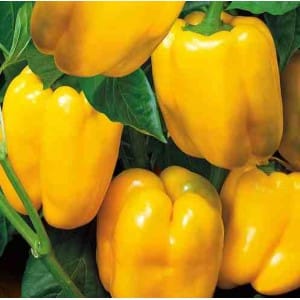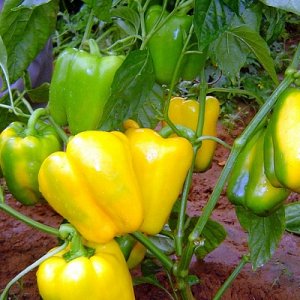Dutch hybrid pepper "Gemini f1": reviews from experienced farmers and rules for caring for it
Pepper is a vegetable that can pleasantly surprise you with its taste and beneficial properties. A bright representative of the new generation of selection - Bell pepper Gemini f1. It is not for nothing that Holland is considered a leader in the production of plant hybrids. The crops bred by the breeders of this country have always attracted gardeners. Dutch hybrids are particularly stress-resistant, have excellent taste and high yield. Gemini pepper has all these qualities. Therefore, many gardeners choose it to grow on their site.
What kind of pepper is this

Translation of Gemini from English means "Gemini". The plant probably got its name because of the high similarity in appearance of the fruits - all the peppers are the same, like twin brothers.
The plant's seeds are produced by the Baer company. The agricultural company holds leading positions in the markets of many countries. Its products are chosen not only for private use, but also for cultivation on farms.
Hybrid f1
Gemini is a hybrid crop, that is, obtained by crossing parental varieties. Packaging with planting material always has the letter f1. In order to obtain the declared characteristics of a hybrid when growing (yield, fruit size, taste), it is necessary to carefully follow the rules of agricultural technology.
At the end of the growing season, seeds from the fruit are not suitable for further cultivation, since they do not retain their genetics.Planting material will have to be purchased again, although the cost of hybrid seeds is quite high.
Characteristics and description of the variety
The Gemini pepper bush f1 is medium-sized, reaching a maximum height of 50 cm. The leaves are dark green. A large number of leaves are formed on the bush, which protect the fruits of the plant from exposure to the sun. It has a powerful stem that can withstand the load of heavy fruits.
The first fruits begin to bear 3 months after planting the seedlings. An important feature is its resistance to all common diseases. From one plant you can collect about a dozen large fruits.
Distinctive features
Gemini f1 is recognizable due to the rich yellow color of the fruits, which have almost the same size and shape. Pepper does not have any critical defects; the manufacturer claims high seed germination and a pleasant taste of the fruit.
Fruit characteristics, yield

The fruits are bright yellow and cubic in shape. They reach a weight of 200 g if the cultivation site is open ground, and 300 g when cultivated on protected soils. The walls of the fruit do not exceed 8 mm, the stalk is freely separated.
Peppers have a great taste with a slight bitterness. Even if the harvest was harvested before maturity and the fruits ripened in storage, they do not lose their excellent taste. Peppers can be used for conservation, so fresh.
Preparation for cultivation
The soil used for seedlings must be light, contain the required amount of nutrients and have drainage properties. For preparation use sand (1 part), humus (2 parts) and earth (1 part).All ingredients are mixed.
Any shallow box or box that can hold soil and moisture is suitable as a container for seedlings. There is no need to treat the seeds in any additional way, since they are already prepared by the manufacturer for planting. Planting material is germinated at a temperature of 22 to 27 °C, soaked in a damp cloth or on a cotton pad.
Growing seedlings (with and without picking)
Which method of growing pepper seedlings to choose - with or without picking - each gardener decides for himself. To avoid replanting, which damages the root system of plants, seeds are immediately sown in separate containers or peat tablets. If this is not possible, planting is carried out in a common box. Then, when real leaves appear, they are picked into separate cups.
Planting pepper
The time for planting seedlings depends on the subsequent method of planting in the ground. At the end of January, seeds are sown for growing peppers in a greenhouse, in the first half of March - for cultivation in open ground. The soil must be pre-moistened before planting. No fertilizer is required during sowing. It is important to maintain a planting depth of no more than 2 cm. At a greater depth, seedlings will be late and the plants themselves will be depleted.
Further care
After sowing, they provide optimal soil and air moisture and maintain the required temperature conditions. Water the seedlings only with warm water. If all planting and plant care conditions are met, the seeds will sprout after 14 days.
With the appearance of the first shoots, maintain a temperature of no more than +24 °C and provide the seedlings with constant lighting. Daylight hours should be at least 12 hours.If this condition is not met, the bushes will stretch out and become deformed.
By the time the first two true leaves are formed, the seedlings are fertilized with mineral fertilizers. They use ammonium nitrate, superphosphate and potassium fertilizers diluted in water. The fertilizing procedure must be repeated 14 days after the first; the amount of fertilizer applied is doubled.
You can start planting seedlings in a greenhouse or open ground after 50 days. It is important to harden. To do this, it is necessary to accustom the peppers to lower temperatures, sun and winds by taking the seedlings outside. By the time of planting in the ground, at least 5 leaves should form on each bush. An important condition is that the soil warms up to at least +13 °C, otherwise the plant’s root system may die.
Features of growing the variety and possible difficulties
Growing the Gemini f1 hybrid requires frequent watering of the soil, under-bush loosening and fertilizing. Another mandatory requirement is mulching, which helps provide roots with protection from temperature changes and retains moisture in the soil.
Feeding is carried out 3 times:
- 7 days after planting in the ground;
- when the plant blooms;
- when fruits begin to form.
As a fertilizer, it is enough to use fertilizer containing phosphorus and potassium. You cannot use fertilizers with chlorine - the hybrid does not like such fertilizers.
The formation of a bush is carried out in one stem. All emerging shoots are removed. The first flower that appears is cut off, this will allow the plant to form more friendly ovaries in the future.
Attention! Since the fruits of the hybrid are heavy, tying the bushes to a support is mandatory.
Typical diseases and pests
Gemini pepper f1 is resistant to diseases and pests. But under unfavorable growing conditions, the plant may suffer from diseases and insects.
There is a high probability of encountering the effects of:
- whiteflies;
- spider mite;
- slugs;
- aphids.
Garlic and onion infusions, manual collection and, in extreme cases, chemical means of protection are used against insects.
Pepper is susceptible to diseases such as:
- anthracnose;
- spotted wilt;
- fusarium wilt;
- crown rot;
- white rot;
- gray rot;
- blackleg;
- late blight;
- black spot;
- cladosporiosis.
All known diseases of peppers can be divided into several types: simple, complex, fungal and viral.
To avoid infection, it is important to carry out prevention:
- avoid waterlogging of the soil;
- avoid sudden changes in temperature if the plant is grown in a greenhouse;
- be sure to fertilize;
- remove and destroy the plant affected by the disease;
- For planting, do not use areas where infected plants were previously discovered.
Many pepper diseases cannot be treated, so prevention rather than treatment is the best option.
Advantages and disadvantages of the variety
Like any culture, Gemini f1 has its advantages and disadvantages.
Let's list the advantages:
- the hybrid is early ripening, with the fruits ripening at approximately the same time;
- the fruits are large and have an attractive presentation;
- excellent taste, which remains unchanged, regardless of whether the fruit ripened on the bush or ripened after picking;
- well protected from the effects of viral diseases;
- a rich harvest from every bush;
- versatility in the use of fruits.
Flaws:
- due to the large number of large fruits, the bush needs support;
- It is necessary to fertilize, otherwise the thickness of the fetal wall will decrease.
Reviews
Summer residents highlight the high germination of seeds, the bright taste and color of the fruit. As a rule, there is no negative attitude towards this variety.
Irina, Taman: “I’ve been growing Gemini f1 for several years with great pleasure. The seeds germinate quickly, and in open ground the plant produces a lot of fruit. I use it fresh for salads; yellow peppers look beautiful in winter preparations.”
Alevtina, Syzran: “I used to be suspicious of hybrid seeds. But I decided to try Gemini pepper f1. I tried to follow all the rules of growing: I fed it, did not allow it to become waterlogged, and did mulching. Imagine my surprise when the bright, beautiful peppers ripened almost simultaneously, all identical and identical. I advise everyone to grow this pepper now.”
Mikhail, Orel: “Farmers know that hybrid seeds are great for growing vegetables in large quantities to sell. So Gemini pepper f1 showed its best side. Of course, it requires care: fertilizing, regular watering and tying up the bush are necessary. But the result is worth it - the bright yellow, beautiful fruits don’t sit on the counter.”
Read also:
Very bright and surprisingly tasty Chanterelle pepper.
What are the health benefits of cayenne pepper and how to grow it correctly.
Conclusion
Gemini pepper f1 is popular among both amateur gardeners and professional farmers. Proper cultivation will certainly reward you with a bountiful harvest. It is only important to follow simple cultivation rules: feed and regularly water the bed with sweet peppers.
After the stage of technical maturity, peppers are perfectly preserved for two to three weeks, which is convenient for transportation. Excellent taste, resistance to major diseases and smooth ripening of fruits allow this hybrid to be a frequent visitor to garden plots. Try growing Gemini peppers, and the bright yellow twin peppers will decorate any salad or winter preparation.